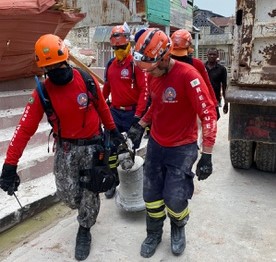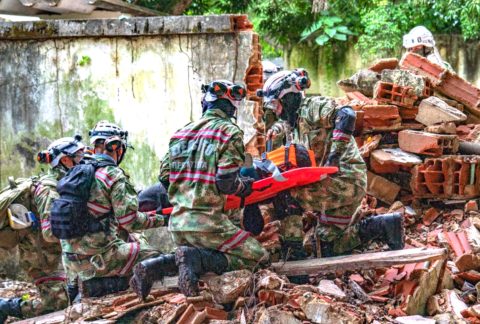The Brazilian Air Force (FAB, in Portuguese) carried out another humanitarian aid mission to Haiti and sent five tons of food, medicines, solar panels, and water purifiers aboard a KC-390 Millennium aircraft that took off on September 11, 2021.
The operation was part of a joint effort by the ministries of Justice and Public Security, Defense, Foreign Affairs, Health, and Regional Development (MDR, in Portuguese), to provide assistance to the population of Haiti, following the magnitude 7.2 earthquake that struck the country on August 14, 2021. In August, the Brazilian government, through the Multidisciplinary Humanitarian Mission, sent more than 10 tons of medical supplies and emergency equipment to the country.
According to the FAB, the KC-390 took donations to Brazil, and brought back service members from the Fire Brigade and the National Public Security Force, who had arrived in Haiti on August 23, 2021.

The Brazilian humanitarian mission worked jointly with envoys from other countries, such as Argentina, Canada, Mexico, and the United States. The initial activities were concentrated in the city of Les Cayes, located 200 kilometers from the capital Port-au-Prince. “We provide work assistance, helping to build shelters, distribute supplies, evaluate buildings, and [bring] medical care. We also train Haitians to use the water purifiers that we brought and donated to the country,” said to the FAB Armin Braun, general coordinator of the humanitarian mission and director of the Brazilian National Center for Risk and Disaster Management, an agency linked to the MDR.
According to the MDR, part of the cargo sent by the Brazilian mission, some 2 tons of material, was used to restore operations at the Corail Hospital. In addition to providing medical assistance, Braun’s coordinated effort assisted in the assessment of structures at risk of collapse, demolition of condemned buildings, and in repair work for structures that were damaged by the quake.
“The teams were distributed in cities on the island. In Torbeck, structures damaged by the earthquake were repaired or demolished. The work was difficult and required advanced techniques directly related to search and rescue activities in collapsed structures,” said the MDR. “The preservation of local culture was one of the goals. In Côteaux, buildings that threatened other buildings were demolished to preserve churches and schools,” he added.
Brazilian Ambassador to Haiti Marcelo Baumbach recalled the country’s history of collaboration with Haiti. “After the earthquake, the entire infrastructure of the country was highly compromised, but our people did an exceptional job during the period they were here. We continue to maintain the standard of quality care, increasingly strengthening the ties between the two countries,” he told the FAB website.
According to the FAB website, Haiti’s director general of Civil Protection, Jerry Chandler, thanked them for their help. “Brazil’s track record of support to Haiti is very rewarding for our country. We know that we can always count on the collaboration of this great nation to help us,” he said.









